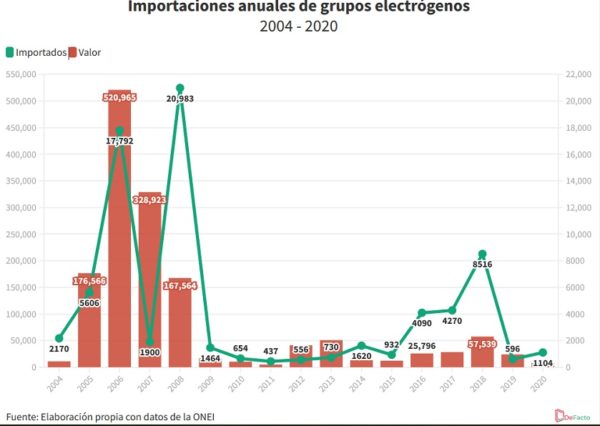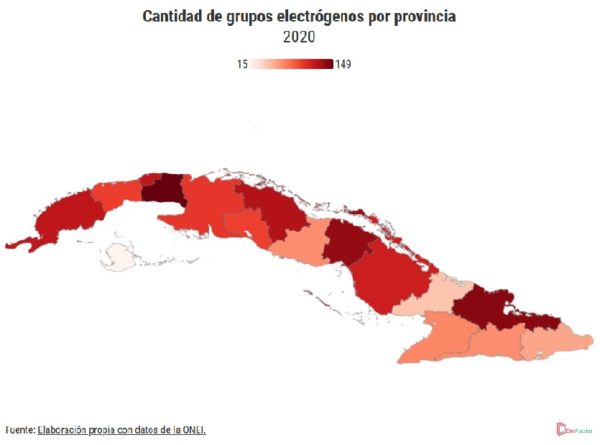Cuba’s Power Crisis: What Happened to the Gensets?

By Olivia Marin Alvarez (El Toque)
HAVANA TIMES – Cuba has imported over 70,000 gensets since 2004, according to statistics from Cuba’s Office of Statistics and Information (ONEI). These machines have been used on the island since the 1990s, to relieve the burden on power plants forming part of the National Electricity Grid (SEN).
Nevertheless, it doesn’t function properly when the country faces shortages of fossil fuels, as they depend upon these. A lack of funding for spare parts and materials needed to maintain them has meant that gensets have faulty parts.
Periodismo de Barrio and El Toque answer some questions to understand what has happened to electricity generation using gensets.
How do gensets used in Cuba work?
Gensets are machines made up of a primary engine of internal combustion and a generator with an alternator, which are mechanically connected to produce electricity, and they can consume fuel oil, diesel or natural gas, ONEI explains.
They can work in two ways: connected to the National Grid to solve deficits in power and contingencies, or as isolated machines, so as to supply electricity to places that the national grid doesn’t reach and to provide an emergency supply, when there is an error, disconnection or not enough electricity at key production units in the country. Using them in case of emergency is stipulated in Resolution 299/2015 by the Ministry of Energy and Mines (MINEM).
On September 16, 2021, Nicolas Livan Arronte Cruz, minister of Energy and Mines, spoke on the subject on the Mesa Redonda TV show. He explained that gensets used in Cuba run on diesel and fuel. The former cover peaks in high demand and supply electricity in the case of faults or maintenance of the larger power generating plants; while the latter form part of the system’s basic electricity generation.
How many gensets are there in Cuba?
According to ONEI statistics, Cuba imported a total of 73,420 gensets between 2004 and 2020. They were installed on their own or connected up to the Grid.
The highest imports were recorded in 2006 and 2008, with 17,792 and 20,983 gensets respectively. Imports began to drop in 2009, but they grew again in 2016, reaching a maximum of 8,516 units in 2018.

In 2020, there were 1527 gensets connected to the Grid, a relatively low number compared to imports in recent years. The regions with the most gensets installed are Mayabeque (149), Holguin (140) and Ciego de Avila (136); while the Isle of Youth has the lowest number in Cuba: 15 gensets.

Out of the 1527 installed, 977 run on diesel and 550 run on fuel. The number of fuel gensets hasn’t swayed much in recent years, but the number of diesel gensets has grown compared to 2016.

Despite the number of gensets not changing in 2019 and 2020, the power of installed ones dropped from one year to the next, from 3056 GW (Gigawatts) to 2696.6. This was a result of diesel gensets dropping in power from 1677.6 GW in 2019 to 1318.2 GW in 2020, while the power of fuel ones remained at 1378.4 GW over both years.
This is the maximum continuous rating that a generator block or unit can supply measured at the generator’s terminal, the ONEI points out; that is to say, the amount of electricity it can generate.
Meanwhile, electricity generation – measured in watts per hour (GWh) – measures power transmitted over a certain period of time, in this case, an hour. In 2020, national electricity consumption stood at 17,003.8 Gwh.

It’s important to note that even though there are less fuel gensets connected to the Grid, they are able to generate more electricity than diesel ones. In 2020, the latter contributed to 6.4% of the island’s total electricity generation, while the former contributed 14.35%.
Why did they start using gensets in Cuba?
The energy crisis in Cuba in 2004 led to the Government seeking out new electricity generation alternatives, as the capacity and technical condition of power plants was insufficient to cover increased demand.
In a speech given on January 17, 2006, Fidel Castro said that a profound analysis of the situation and experiences dealing with strong hurricanes led the Government to put new concepts of developing a more efficient and safe electricity grid into practice.
“The power plant system will gradually be replaced by the new generation of motors, including those with a combined cycle, and the basic resources needed to keep these units working efficiently have been allocated. Other units will be conserved and will be ready to work when the system needs them, while the initial transformation phase of the current system takes place,” Castro said at the time.
Actions adopted under the policy known as the “Energy Revolution” involved the purchase and installation of safer and more efficient electricity generation machines, with gensets and motors conveniently placed in different groups across the country; increased use of gas along with national fuel in electricity generation using a combined cycle; fixing up old and inefficient distribution networks that affected the cost and quality of electricity supplies; giving priority to the basic resources needed for power plants part of the grid to work properly and for their upkeep, as well as creating an intensive research and development program for wind and solar energy in Cuba.
The main advantages were low levels of fuel consumption for electricity generation; the lack of a significant impact on the system in the case of a fault; in addition to the ability to install them in geographic spots that would contribute to protecting electricity services to the population and meeting economic and social objectives in the case of extreme weather phenomena and faults.
Castro estimated that the country would save 1 billion USD per year with the new Grid, that it would supply four times the energy capacity needed and, that by late 2006, power plants consuming excessive amount of fossil fuels could be shut down, replaced by new generation plants.
However, in 2021, 59.9% of Cuba’s electricity is still generated by power plants.
Power plants: between obsolescence and a “lost” investment of 1.2 billion euros.
Only thermal generation is able to meet national consumption needs in the short-term. However, constant faults recently warn of the urgency of investments that the country has no way of paying.
What are the environmental consequences of using gensets in Cuba?
Using gensets gives rise to health risks linked to loud noise levels while running, the contamination of superficial and underground water, and the emission of pollutant gases in the atmosphere. While there are laws that regulate this, the emission of greenhouse gases that affect air quality has been one of the problems that gensets pose in Cuba.
A study carried out by the National Institute of Hygiene and Epidemiology analyzed seven samples to determine the concentration of sulfur dioxide and nitrogen dioxide in areas near gensets in Havana.
The results showed that concentrations of nitrogen dioxide exceeded the maximum admissible concentration (MAC) over a maximum of 20 minutes and daily averages in the areas examined, while sulfur dioxide concentrations were lower than the MAC.
Another study published in the Cuban Meteorology Magazine evaluated the variation of pollutant gas emissions by gensets in five Sancti Spiritus neighborhoods between 2008 and 2015. The study revealed that there was a growing trend of gas emissions and a deterioration of air quality over this period, as a result of gensets becoming less efficient in generating electricity.
The document says that the most emitted gas was carbon dioxide (98% of total emissions), followed by sulfur dioxide (with a concentration of 0.008%), nitrous oxide (0.007%) and carbon monoxide (0.001%).
Have gensets really solved the National Grid’s problems?
While in theory the installation and operation of gensets should have relieved the burden on power plants, in practice, there are two key problems with gensets that have made it hard for them to do this: fuel shortages and machine overuse.
On the one hand, these machines contribute to Cuba’s dependency on fuel imports that has been going on for over three decades. In 2019, Cuba produced 447,000 tons of diesel and 755,300 tons of fuel oil, while consumption rose to 1,458,100 tons of the former and 4,833,700 tons of the latter. This year, Cuba had to buy 729,800 tons of diesel and 1,342,800 tons of fuel oil abroad to cover at least some of the total demand of these two resources.
The supply deficit of them both means that electricity generation plants can’t produce enough electricity or replace electricity generation of thermal plants in the case of faults or breakdowns.
On May 25, 2022, President Miguel Diaz-Canel gave a speech before the Council of Ministers and said that “it’s been very hard to get offers to cover this fuel situation in time, and they are analyzing variants of combined operations to reduce electricity generation deficits, every day.”
On the other hand, the overuse of gensets, as they are always running and a lack of parts and resources for their upkeep, also reduces their ability to generate electricity.
Gensets can receive two kinds of maintenance. Prevention: this involves interventions to prevent faults and includes changing filters and lubricating oils, checking water, oil, fuel levels and battery charge, as well as cleaning and checking the motor on a regular basis. Corrective maintenance: this is done if the report from preventive maintenance identifies a fault.
In Cuba, preventive maintenance should take place when the genset reaches 2,000 hours of work. Later, when it reaches 6,000 hours, it’s given more thorough maintenance, and an overhaul at 12,000. The country has two companies responsible for maintenance: the Gensets and Electrical Services Company (GEYSEL) and the Maintenance of Fuel Oil Gensets (EMGEF), which have offices in the provinces.
A thesis by the Department of Mechanical Engineering at the University “Marta Abreu” of Las Villas explains that preventive maintenance of these machines should only be done of the engines and not the other components, which should receive corrective maintenance, due to the economic conditions in Cuba that prevent the purchase of spare parts.
While the study was carried out in 2012 and doesn’t have up-to-date statistics on the matter, in September 2021, Edier Guzman Pacheco, director of thermal generation of Cuba’s State Electricity Co. (UNE), admitted shortages of materials, supplies and parts needed for upkeep and the repair of gensets, and said that these conditions had led to their lower technical operation.
Alternatives have been sought-out by national industries, and in September 2021 it studied 674 pieces to set up genset engines, so as to replace imports and save financial resources, Guzman Pacheco said at the time.
Nevertheless, despite these efforts, gensets were out of 1134 MW power because of faults and 539 MW because of maintenance work in June 2022, UNE explained.
This article is a collaboration between El Toque and Periodismo de Barrio.





